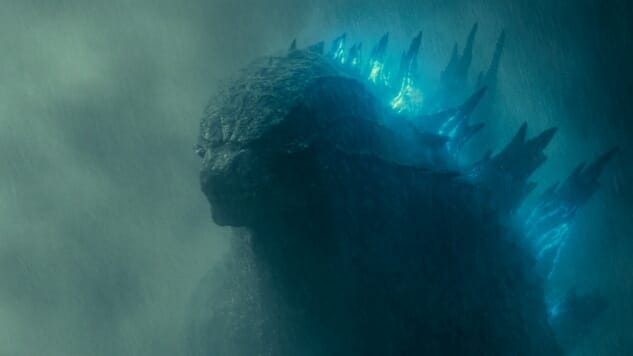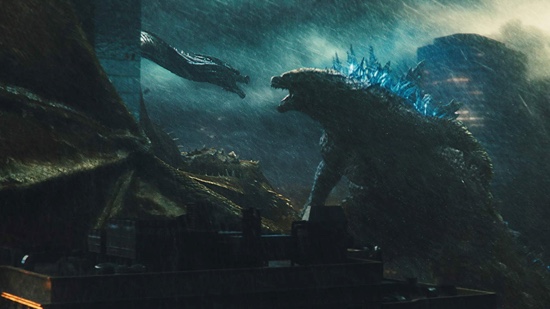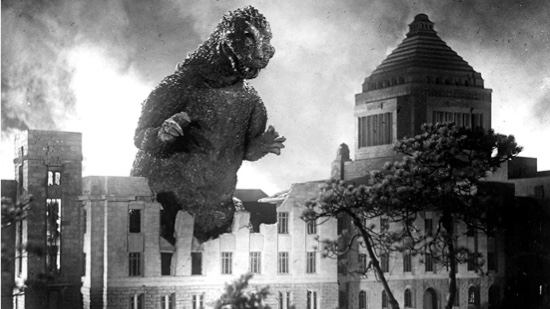Godzilla Is Better When He’s an Unholy Terror
At 65, cinema’s longest-running series is still rooted in our apocalyptic fears.
Movies Features godzilla
Note: Be sure to read Paste’s full review of Godzilla: King of the Monsters by Dom Sinacola and beware of spoilers for various Godzilla movies.

Maybe it’s the unrelenting horror of the news, or the inexorable graying of my body, or the fact I’m currently trying to end service with one cable provider and transfer to another, but the central message of the Godzilla movies seems especially resonant lately. That message, of course, is that humans are puny idiots who have no claim to this planet, whose contrivances pale in comparison to the casual violence of nature red in tooth and claw, and who deserve to be devoured by it. Godzilla (as he’s known in the West) was the incarnation of the fear of nuclear devastation when he first debuted in 1954.
The series took a hard pivot toward fun-loving monster-vs.-monster devastation afterward, and has always had an ironic streak to it on both sides of the Pacific, but watch Ishiro Honda’s original version and it’s impossible not to see an entire nation confessing its justifiable fears of unstoppable mass destruction and the invisible blight of radiation. Like the 2014 debut that kicked off this “MonsterVerse” and some of the very best entries of the series, this year’s Godzilla: King of the Monsters is based around towering monster battles that make its human cast seem completely superfluous. (You can dive into our own exhaustive ranking of the entire series here.) While this sequel takes a confusing approach toward making Godzilla both the embodiment of climate catastrophe and our savior from it, it mostly excuses the real villain: us.

Japanese cinema abided under censorship during the American occupation in the wake of World War II. Gojira was the first in the kaiju (giant monster) genre, and the first in what is still recognized as the world’s longest-running continuous film series, but it was also a statement on what had been done to the country that created it. The reality of nuclear devastation, of radioactive fallout, of weapons of mass destruction theretofore unknown, were being aired in the form of a special effects-heavy film.
It’s unfortunate most Americans never saw it at the time. Drastically recut to insert a white actor, with much of the nuclear subtext scrubbed from it, the 1956 version, Godzilla: King of the Monsters became a sensational monster movie and in a lot of ways, an object of fun rather than fear. Juxtapose it with the elegiac original and you understand why Blue Oyster Cult made a cheerleading song and the nuclear death lizard himself has appeared in multiple cartoons.
The original was released in the West in 2004, long after it could’ve hurt anybody’s feelings. The rubber costume with its googly eyes and snarling grimace only hold up depending on your own suspension of disbelief, but what unquestionably holds up 65 years later is that deep-throated roar, the images of mankind’s infrastructure burning and melting and exploding, its tanks and jet fighters powerless as the lamentations of Godzilla’s thousands of victims echo over a Tokyo that’s been reduced to a sea of fire.

“Watching the film, we understand how Godzilla feels. It isn’t a villain. Its lair was destroyed, so it was roused to anger. It isn’t particularly malevolent. Even children can understand Godzilla’s feelings.” —film journalist Tadao Sato
As with Terminator or basically any other work that bears the name of the bad guy, it’s inevitable that the audience will root for the monster. Godzilla is perhaps more sympathetic than most: His backstory is always that he’s slumbering somewhere out of humanity’s way when their hubris inevitably wakes him up, with predictable results. It’s understandable that Godzilla has been a hero many times in the numerous films that have followed, but it robs the beast of some of his grandeur.
The American-made movies, 2014’s Godzilla and now director Michael Dougherty’s Godzilla: King of the Monsters, position him as a creature whose destructive tendencies are at least targeted at other monsters rather than humanity. While this year’s sequel keeps namechecking climate change (which as our own Dom Sinacola points out is just standard practice now), it’s a bit of a muddled message. The eco-terrorists seeking to rectify the situation suffer from the Killmonger conundrum, i.e., they are obviously in the right but we can’t root for them because they use terrible, unhinged tactics—in this case, waking up King Ghidorah and the other ancient monsters. The humans discover that King Ghidorah is actually an invasive species, so I guess the full severity of this problem isn’t really on us after all. And rather than function as the heedless vengeance of nature, the credits scenes seem to imply that the murderous radiation that always follows in Godzilla’s wake is actually doing things like repairing the Great Barrier Reef.

King of the Monsters is some wild fun that ends in the human characters gawping in terror at a roaring Godzilla surrounded by the monsters who have no choice but to bend the knee, a scene very much in line with the spirit of a lot of those Toho productions, which gave us plenty of ludicrous kaiju smackdowns and were not above simply hurling every conceivable monster at Godzilla, only for them to have their scaly asses kicked.
If you want a real return to the original spirit of that unexpectedly grim and pensive Gojira from 1954, though, we got it in 2016 courtesy of Neon Genesis Evangelion mastermind Hideaki Anno’s Shin Godzilla, a movie that paradoxically contains lots of scenes of bureaucracy and politicking and yet might be the best Godzilla movie I’ve ever seen.
Shin Godzilla, a standalone remake of the original movie, features scene after tensely edited scene of government agents who are frantically trying to respond to an impossible scenario in realistic ways. Japan’s own Constitution is invoked at one point: How can the nation’s Self Defense Force respond to a giant nuclear death lizard if the law of the land specifically disallows mobilization except in the face of “an armed aggressor nation?” Faced with opening fire on the beast when civilians are in the line of fire, the prime minister balks and aborts, speechifies about how he can’t abandon Tokyo now. His chopper then gets unceremoniously nuked out of the air by Godzilla, because Shin Godzilla also features some of the most awe-inspiring destruction of any in the series.
It’s impossible not to see a statement on what awaits all of us as the seas rise, as hurricanes grow in power, as we keep voting in governments that are more interested in being mean to brown people than in fixing our sewage systems and cutting carbon emissions. Rooms full of smart, serious people will huddle around screens, gray old men with brass on their hats will assure some overwhelmed guy in a suit who got himself into it for the media attention and the pension that they’ve planned for every contingency.
They are all of them nothing to Godzilla—a monster birthed in his creator’s minds by the Bomb and the quake and the storm, and our puny and shortsighted responses to them. A town hall official in the very first movie cautions against alerting Tokyo of the giant nuclear death lizard because it might harm the economy. As we increasingly despair of a global society that wakes the hell up and realizes there will be no economy at this rate, it becomes harder and harder not to cheer on the king of the monsters and hope we aren’t the ones who end up underfoot.
Kenneth Lowe, they say he’s got to go, go go Godzilla! You can follow him on Twitter or read more at his blog.